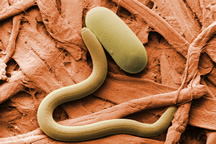|

Low-temperature
scanning electron micrograph of soybean cyst nematode and its egg. Magnified
1,000X. (Plate # 10334, courtesy ARS Electron
Microscopy Unit). Click image for 300-dpi version.
|
New Soybean Line Offers Strong Resistance to
Nematodes By Jim
Core
July 29, 2004
A new soybean line from the Agricultural Research Service and the
University of Missouri delivers
a rare combination of resistance to two leading nematode pests. The release is
good news for consumers of edible natto soybeans.
The germplasm line, designated S99-3181, was initially bred for
resistance to both soybean cyst nematode (SCN) and southern root-knot nematode
by Grover Shannon, a soybean breeder at the
University of Missouri's
Delta Research Center in Portageville, Mo. Prakash R. Arelli, a geneticist
at the ARS Nematology Research Unit in Jackson, Tenn., identified S99-3181 for
its resistance to SCN.
Natto soybeans get their name from a Japanese fermented soybean
dish most commonly eaten at breakfast on top of rice, but it is also used in
other dishes and during other meals.
Very few soybean lines, especially natto type, have this
combination of broad nematode resistance and high yield potential, according to
Arelli. In fact, during field trails, its yield was found to be equal to, or
higher than, yields of Hutcheson, a popular cultivar. Additionally, the line
also has shatter resistance, which means it will hold its seed after maturing.
The new line has broad resistance to SCN, the most destructive
soybean pest in the United States, causing annual losses as high as $438
million. The cyst nematodes attack the roots of developing plants. Root-knot
nematodes are the second most destructive soybean pest in the southern United
States.
The line is expected to be used as a parent in breeding programs
to develop new varieties that reduce soybean yield loss and reduce the need for
pesticides. But growers might want to plant S99-3181 seeds directly, according
to Arelli.
The new line is a cross between S93-1344 and Camp. Arelli uses
traditional breeding and marker-assisted selection to find new resistant genes
in soybeans.
ARS is the U.S. Department of
Agriculture's chief scientific research agency. |